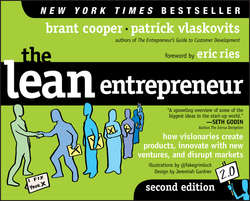Читать книгу The Lean Entrepreneur - Vlaskovits Patrick - Страница 11
На сайте Литреса книга снята с продажи.
1
STARTUP REVOLUTION
BYTES EATING THE WORLD
ОглавлениеIn 2011, famed Internet-entrepreneur-turned-venture-capitalist Marc Andreessen described how technology companies are disrupting entire industries. He called this phenomenon “software eating the world.” He declared:
Six decades into the computer revolution, four decades since the invention of the microprocessor, and two decades into the rise of the modern Internet, all of the technology required to transform industries through software finally works and can be widely delivered at global scale.5
Indeed, software is ubiquitous – it’s in your car, phone, stereo, camera, and TV. Software is critical to any modern business. Customer management, logistics, resource planning, inventory control, human resources, accounting, factory automation – all are made up of software, software, software. The same is true of the consumer experience: We buy books, watch movies, listen to music, and play games created or distributed by software companies: Amazon, Netflix, Pandora, Apple, Zynga.
The line between software companies and traditional-product companies is blurring to the point of making the distinction irrelevant.
Innovative software coupled with new electronics has resulted in new ways for computers and people to interact (human–computer interaction or HCI), resulting in what investor Brad Feld of the Foundry Group calls “instrumenting human beings.” We are at the very infancy of HCI and its natural progression toward a “symbiotic human–computer future.”6
The open-source software movement, which helped lower development costs and drove innovation in the personal computer world, is now emerging in the computer networking industry led largely by Google’s G-Scale Network and the use of the OpenFlow protocol.
Have we mentioned hardware? And materials science? Massively disruptive technologies, such as 3D printing, are enabling the first wave of mass customization that will threaten manufacturing-based economies. Movements are well underway to open-source hardware-development technologies and create hardware components that can be used across different companies, even in different industries.
“For the last hundred years and definitely for the last thirty years, manufacturing has ostensibly been treated as a solved problem,” says David ten Have, CEO and founder of Ponoko, a web-based platform for digital fabrication. “The reality is that it is just a plateau that we’ve been sitting on, and some technologies and some social forces have come into play that have caused us to push off the plateau.”7
DIGITAL FABRICATION:
Process that combines 3D modeling and additive manufacturing technology to produce models, prototypes, and, most significantly, functional products.
Digital fabrication is giving small businesses the ability to manage inventories like Fortune 100 companies. Suddenly, experimentation with new products and disruptive innovation is not so risky.
This also matches up with the trend toward people making products to solve problems in their own communities. Businesses are moving away from producing for the masses, and toward more local, niche markets.
The culture of open-source software – which permits users free use of code under specific conditions – is another death knell for the big-business-protecting patent system. (Not that this will be a quick death.)
Current digital-fabrication technologies are at the state of one of the first fully assembled personal computer circuit boards, the Apple I, developed in 1976, estimates David ten Have. If true, this means that 3D printing, open-source hardware, and other digital-fabrication technologies will have a massive impact on our economy.
5
http://online.wsj.com/article/SB10001424053111903480904576512250915629460.html.
6
Brad Feld notes come from a personal interview.
7
David ten Have greatly helped our understanding of emerging digital-fabrication trends.
